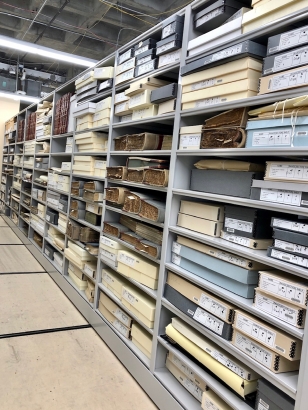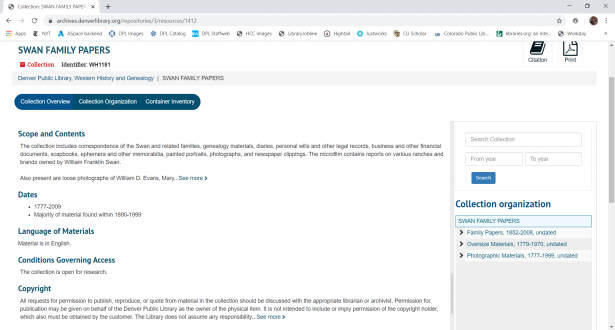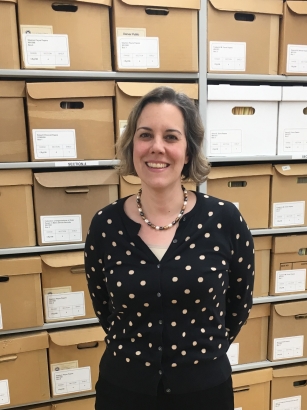(During Denver Public Library's unprecedented, indefinite closure due to COVID-19, WHG librarians, archivists, catalogers, and shelvers are faced with a monumental task: maintain library operations without the actual library. We're up to the task and wanted to share our work stories with our WHG customers in an ongoing series of blogs.
The second installment comes from Archivist Librarian Laura Ruttum Senturia, who describes what archivists do from home (hint: it’s similar to what they do in the office!)
What do archivists do when working from home? Good question! It’s perhaps better to start with what they do in normal times when they’re working onsite at their library or archives. Interestingly, the answers to these two questions can be very similar!
As archivists out and about in the world, we often encounter confusion about our job and what it entails. Casual questions from new acquaintances are often cause for stumped expressions, as most are expecting a familiar answer (for example, teacher, doctor, engineer, etc.). Thus, many folks mishear my reply, and I have been mistaken for an activist or an architect. My personal favorite was the perplexed query, “do you do church records?” I replied that we do often hold those, as well as the records of private families and businesses. The speaker and I looked at each other in silent puzzlement until he asked me if I had gone to music school. Aha! He assumed I had said “organist!”
Humor aside, our current unusual stay-at-home situation has all library staff working from home, and I’ve experienced a number of family and friends asking curiously if we’re “even able” to do so. The fortunate answer is that there is indeed a significant amount of our regular work that the library staff, and in particular the seven of us who work in the archives, are able to do from home.
While each of the twenty staff members of the larger Western History and Genealogy department is focusing on slightly different projects, some of what we're doing is pretty similar across the board. Many of us have been creating social media content to keep our homebound audience entertained, writing blogs and educational materials for students, or working on collection development (as Brian noted in the first post in this series). On top of that, many of us will soon be answering reference questions by phone (more information on that coming soon). We’re also doing a lot of planning work right now, including discussing new service and programming ideas that will improve Western History and Genealogy’s future offerings.
An additional project for us archivists has been working our way through a gargantuan data migration that will make it easier to learn what's in our collections and how to access them. That's what archives work is all about.
Before getting too far into discussing that project, however, I'd first like to give some background on what we normally do: archivists are tasked with documenting and preserving information on past and present society for use by future generations. Our bread and butter are records created by individuals and organizations in the course of their daily activities— diaries to letters, financial and business materials, photographs, born-digital and audio-visual items, even art and 3-D artifacts—which we then assess, physically organize, catalog, and describe. Finally, we create multiple means for future researchers to discover and use these collections.
The work of organizing and describing materials is called “processing,” and the final product is generally a row of orderly boxes containing tidy folders, all described in something called a “collection guide,” or “finding aid.” A processed collection is a beautiful thing to behold, a balm for those of us struggling with chaos.
After processing, our cataloger then describes collections in the library’s online catalog and shares them with OCLC’s Worldcat catalog, so researchers from around the world can find them. We include links to the finding aids in the catalog record, so you can learn exactly what is in each of those (potentially hundreds of) boxes. Finally, we digitize selected items from many collections so you can see the more interesting ones from your sofa, a place where many Coloradans are spending a lot of time these days.
The work that goes into taking a collection from A to Z involves multiple people: from the acquisitions archivist and committee to the archival processor, the cataloger, and the staffer who digitizes material and ingests it into our Digital Collection.
All of this detail-focused work is invisible to the general public, by design. Libraries and archives have a commitment to easing the user’s path to our collections and then stepping back to let them enjoy what they find. We strive to make this journey as simple and seamless as possible for our audience. Much like they say about show business, we make an incredible amount of work look effortless.
So, circling back to the question of the archives work I’m doing from home: our data migration adventure. We are in the midst of moving those aforementioned finding aids into our new search tool. The work has too many oddball variables to automate easily, so what we’re doing is a bit like many of your current projects at home: organizing the odds and ends of your drawers and closets, putting everything aright into a neat existence. I’m gathering information, giving it context, and then popping it all into spreadsheets and databases destined to go online. While we’re not able to touch our collection materials at the library archives, we are still able to forge ahead with work that will be meaningful to future library customers--maybe even you!
This migration project was anticipated to take several years, and COVID-19 has sped up the timeline. In the three weeks since our work-from-home journey began, a small group of us have migrated eight times the number of collections we had done in the few months prior to the closure!
Until we can all get back to business as usual, we’re working diligently behind the scenes to make order from chaos--a fitting analogy to what the whole world is trying to do right now. While we miss seeing our customers, we’ll be even better prepared to welcome all of you back to the library!








Comments
Very nice view of the work it
Very nice view of the work it takes to put "all that stuff" online and make it accessible! You've inspired me to try to do the same.
Hi Kathy. Thanks for your
Hi Kathy. Thanks for your comment, and for sharing the post to the Archives Think Tank! I hope you've got similar projects you can do from home (I know not all archivists do currently). If nothing else, this challenging moment in history will help us make progress on the never-ending behind-the-scenes work! If you do post something, please share. We'd all love to read it.
I love it! What a wonderful
I love it! What a wonderful nuts and bolts description of archival work. You tied it in so beautifully with our current circumstances. Lovely photos by the way ;) particularly the last one.
You are too kind, Herm!
You are too kind, Herm! Thanks for your comment. Only the best photographers contributed content for this post!
This is great!
This is great!
This is great!
This is great!
Thank you, Rosemary!
Thank you, Rosemary!
A great way to display your
A great way to display your indispensable work behind the scenes. Well done!
Thank you, Vasilis! Glad you
Thank you, Vasilis! Glad you enjoyed it.
Laura,
Laura,
I retired last year from the Archives at Regis University. Your 'birds eye view' of archival work was so articulate and informative. I thoroughly enjoyed your accurate description, and the credit you gave to all your partners. Archival work is truly greater than the sum of its parts.
Add new comment